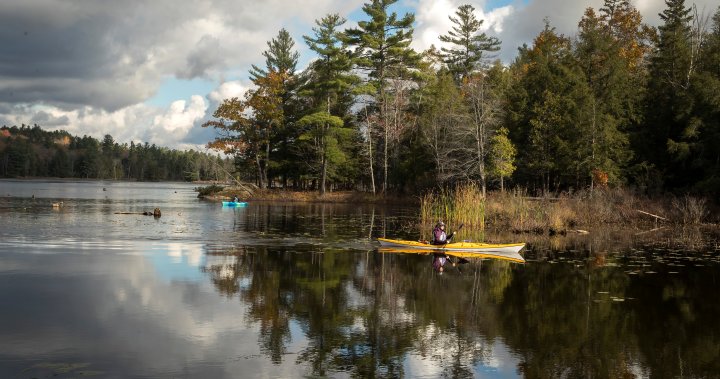
What’s in a garden? In the case of Nina-Marie Lister, a hive of biodiversity.
Lister, a professor of urban and regional planning at Toronto Metropolitan University, doesn’t call her front yard a “garden.” No, it’s an urban ‘meadow’ teeming with all manner of unruly grasses, shrubs, flowers and trees.
Weeds for some, biodiversity for others. She successfully fought the City of Toronto, whose by-law officers were eager to see her meadow mowed down. This urban oasis is, for Lister, rather a recognition of the importance of the natural world, whether in your front yard or in the vast stretches of pristine Canadian wilderness.
Read more:
What can a ‘sponge’ teach us about building resilient cities? Turns out, a lot
Read more
-
![]()
What can a ‘sponge’ teach us about building resilient cities? Turns out, a lot
“We have a long history, especially in the colonial colonial tradition, of distancing ourselves from the wilderness, taming nature, paving it,” she told Global News in an interview last fall. Listen to the manicured lawn, which Lister says is the antithesis of biodiversity.
To make that point, she will travel to Montreal this week to attend COP15, a major United Nations conference all about protecting the planet’s natural ecosystems. The high-level goal of the conference is to protect 30 percent of the world’s land and oceans by 2030.
It’s a smaller, more focused UN conference than the one that just wrapped in Egypt and had very little to show for it. The hope this time is that environmentalists, policy makers and politicians can find enough common ground to conserve and restore more of the world’s natural areas.
Last month, a major report on the state of the world’s species found that more than 2,200 plants, fish and other animals in Canada may be at risk. Then there are the heat waves, floods and fires, which scientists expect will only grow in frequency and ferocity.
The good news, experts say, is a growing recognition around the world that humans and nature can do nothing but co-exist.
“Canadians understand on a deep, instinctive level the importance of nature to our well-being,” says Gauri Sreenivasan, the policy and campaigns director at Nature Canada.
Getting out into nature, she says, has been essential for people’s physical and mental health during the COVID-19 lockdowns and restrictions. The pandemic, she adds, has also made people realize how connected everyone is to the natural world.
“More and more people are starting to see the connection between how (these) essential life support systems keep us all going, that we are all part of nature and that we are all connected.”
That recognition of the protection of nature as a cornerstone of well-being is something that the business world also takes into account. Mike Lyons, a managing director and partner at Boston Consulting Group, says more companies are realizing that cutting their environmental footprint makes good business sense.
“I think people are starting to ring the bell around proactive climate measures much more than we’ve seen in the past.”
In October, his company surveyed 1,600 large companies, many of which linked emissions reductions to everything from improved reputations to lower operating costs to higher valuations.
From a legal perspective, there have been some new measures to protect the world’s natural wonders as well. In Quebec, the Magpie River, a popular rafting destination, has been given ‘legal personality’ status in an attempt to protect it from hydroelectric development.
Read more:
How a river in Quebec won the right to be a legal person
It is part of a growing global movement, pioneered by Ecuador, to extend legal rights to nature.
In Canada, indigenous peoples have known for centuries that steamrolling over nature without careful consideration has extremely negative consequences.
A hundred years ago, a lake in British Columbia’s Fraser Valley, east of Vancouver, was drained to make way for farmland. Last year, the region was hit by devastating floodwaters that would have had a place to live if the lake had never disappeared.
“I think if our people had been listened to a century or more ago … we would be in a much better place now,” said Chief Dalton Silver of the Sumas Nation, which borders the floodplain.
“Why would people even want to do something like that?”
Indigenous peoples lived in the land now known as Canada for centuries before European explorers arrived, and, says Chief Silver, nurtured a relationship with nature that builds on the idea of living and learning with “everything around we.”
Read more:
Sumas First Nation chief reflects on ‘catastrophic’ BC flooding where the lake was
Overlooked for years, that traditional ecological knowledge will be a big part of the upcoming conference in Montreal.
That knowledge, adds Nature Canada’s Sreenivasan, has long offered “a better way to explain our connection to nature (and) how humans are part of nature.”
“We must make use of indigenous knowledge and expertise.”

